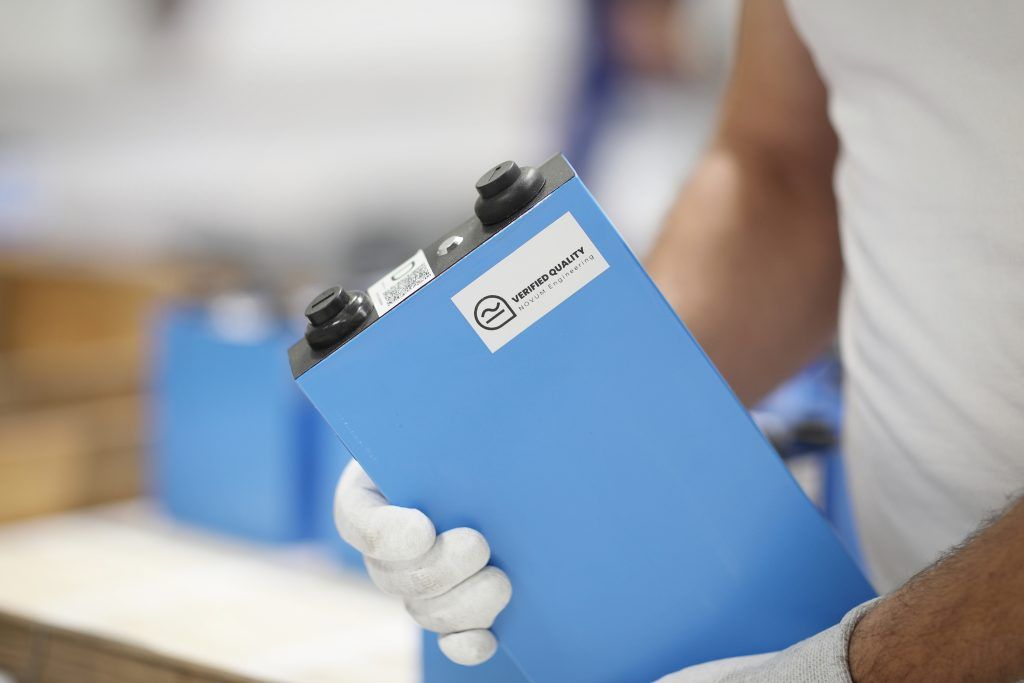When is a battery empty? How long will it continue to function? How much energy can it currently store? Does it possibly pose a security risk? And would it still be worth it when sold? These questions are among the most common for companies that work with and rely on batteries on a large scale.
Inaccurate and costly: weaknesses of conventional battery diagnosis methods
Various conventional methods for battery diagnostics have been available for quite some time. These are created with great effort in the laboratory, in which as many different practical conditions as possible are simulated and the corresponding battery parameters are recorded. The problem is that the simulated laboratory conditions sometimes deviate to a greater or lesser extent from the actual, subsequent use of the battery, so that the corresponding methods for determining the battery condition are fuzzy right from the start. The smaller these are to be kept, the greater and thus more expensive is the preparatory work in the laboratory in order to simulate practical conditions as realistically as possible. Accuracy has thus far been primarily a cost-benefit issue. With a smartphone, for example, it is less dramatic if it suddenly goes out even though the screen has just shown a 20% charge than with an electric car. So far, the higher the cost pressure for certain battery products, the less accurate the condition determination.
Inexpensive, reliable and fast: AI-based battery diagnostics with NOVUM
NOVUM technology opens up completely new possibilities for companies here, because by using artificial intelligence we decouple the achievable accuracy from the costs of laboratory modeling.
Our artificial intelligence learns directly from real-world data. This eliminates the need for time-consuming and costly readjustment in the laboratory. At the same time, accuracy increases because statements about the behavior or condition of batteries in can also be made for the first time on the basis of practical data. The result of our testing is meaningful battery metrics for each individual battery in each use case.
But the patented NOVUM technology can do even more! Artificial intelligence is only as good as the data it has at its disposal. With the aid of a patented measurement method based on electrochemical impedance spectroscopy, it is possible for the first time to “look inside” battery chemistry non-invasively.
For example, we can determine whether there are already problems inside the battery without this already being reflected in a reduction in capacity. Here, in contrast to simple internal resistance measurement, a large number of measurement points are considered instead of just one, so the database that is subsequently analyzed by our AI is far more complex.
This is ideal for artificial intelligence, because the more complex and extensive the data, the better the possible quality of the information. Our customers are also pleased: They receive all relevant information presented in an easy-to-understand way via their user access, so that they can make decisions for their company quickly and based on data.

What does NOVUM’s AI-based battery diagnostics determine?
State of Charge (SoC): Important to know: There is no such thing as a state of charge! Various aspects, including temperature, current, wear condition and production quality, influence the chemical reactions in the battery and thus the state of charge. Unfortunately, the default SoC value of many battery systems does not take this problem into account. Therefore, corresponding statements determined by conventional methods should always be viewed with a certain degree of caution.
The good news is that NOVUM technology can reliably describe the state of charge depending on the situation. It is given as a percentage, where 100% means fully charged and 0% means empty.
+ Decreases with use of the battery
+ Decreases also in passive state
+ Can be described with NOVUM technology depending on the situation
+ Temperature, current, wear condition and production quality influence result
State of Health (SoH): The State of Health describes the ratio of the current capacity to the original capacity of a battery in percent.
+ Deteriorates with aging of the battery
+ Can be determined at any time within seconds with NOVUM technology
+ Gentle use helps delay deterioration of State of Health.
Capacity: The capacity describes the maximum amount of energy a battery can currently store. It can be determined using NOVUM technology and is specified in ampere-hours (Ah).
+ Decreases due to aging of the battery
+ Can be determined at any time within seconds with NOVUM technology
+ Gentle use helps delay capacity reduction
Aging tendency: The aging tendency of a battery describes how strongly a battery reacts to environmental influences. It will be defined differently depending on the manufacturer and described in the spectrum from good to bad.
+ Quality of materials and conditions of production are crucial
+ Can be determined at any time within seconds with NOVUM technology
+ Does not improve with gentle use
+ End-of-line test with NOVUM technology recommended for checking and optimizing the aging tendency or production quality.
Aging: Aging describes the process in which the performance of a battery — as with all electrochemical systems — decreases. A distinction can be made between calendar aging, cyclical aging and erratic aging.
+ A battery ages even in a passive state
+ Aging is accelerated by use and physical effects
+ The aging of a battery is reflected in the State of Health (SoH) value
+ Battery data often allow conclusions to be drawn about undiscovered causes for conspicuous aging symptoms of certain batteries or battery types (e.g. errors during production or use)
+ The deterioration of the State of Health can be delayed by gentle use.
Expected life: The expected life describes the period of time during which a battery will remain functional for a given usage. We warn our customers if a battery is going to fail in the next six months. You can choose whether you want us to predict the expected lifetime with the current usage of the battery or check alternative usage profiles.
+ Decreases with aging of the battery
+ Can be determined at any time within seconds with NOVUM technology
+ Lengthens or shortens depending on how the battery is used
Residual value: The residual value of batteries is particularly exciting for companies that want to resell used batteries or reuse them in rental fleets instead of disposing of them. With our AI, we can provide an estimate of the residual value of individual batteries as part of battery diagnostics.
+ Decreases due to aging of the battery
+ Can be determined at any time within seconds with NOVUM technology
+ Depends on the use case (2nd life in the vehicle or in stationary storage)
When is battery diagnostics useful or necessary?
Knowing the battery characteristics through a battery diagnosis is always useful in principle, because the characteristics of batteries can change depending on the materials used and their quality, the production conditions and subsequent use, but also other unforeseen physical effects, such as temperature fluctuations.
This creates uncertainties and risks for battery users, whether businesses or individuals. The performance and capacity of a battery can decrease, so that devices or vehicles are no longer able to perform certain tasks. Failures may occur and, in the worst case, heating may even occur, which can cause batteries to emit toxic gases, burn or explode.
Particularly problematic is the fact that batteries age even in a passive state. This means that even when batteries are not in use, chemical reactions take place in their cells. This means that they can also become a source of danger during storage or transport.
AI-based battery diagnostics may therefore be useful or even necessary in the following scenarios:
- As part of an end-of-line test during battery production
- After purchase or before installation in equipment and vehicles
- As a regular preventive measure to reduce declining performance or avoid vehicle and equipment failures
- If vehicles or equipment are already causing problems or have failed, and there is reason to suspect that it may be related to the battery
- As a safety measure before transporting or recycling batteries
- In the context of 24/7 monitoring, e.g. monitoring of battery storage systems
What distinguishes NOVUM’s battery diagnostics from other artificial intelligence methods?
In principle, artificial intelligence needs a lot of reliable data over the entire life cycle of the battery. But what if this data is not available at all or not in sufficient quality — e.g. because customers have no way of collecting it or deliberately decide against it? What sets us apart from our competitors is that we don’t rely on our customers to provide us with battery data. Alternatively, we can easily collect all the necessary information ourselves within seconds. To do this, we combine impedance spectroscopy, an advanced battery diagnostic method that uses a range of frequencies to assess battery health, with artificial intelligence evaluation.
How accurate are the results of NOVUM’s battery diagnostics?
With a good data basis, a target accuracy of +/- 1% can be achieved in most cases. How do we know that? Because our AI is monitored all the time by a second AI, which always tells us and you exactly how reliably the first AI is working.




